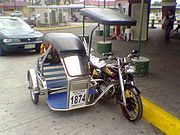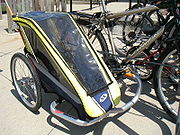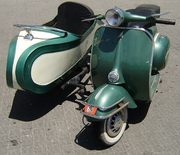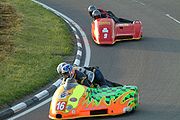
Sidecar
Encyclopedia


Motorcycle
A motorcycle is a single-track, two-wheeled motor vehicle. Motorcycles vary considerably depending on the task for which they are designed, such as long distance travel, navigating congested urban traffic, cruising, sport and racing, or off-road conditions.Motorcycles are one of the most...
, scooter
Scooter (motorcycle)
A scooter is a motorcycle with step-through frame and a platform for the operator's feet. Elements of scooter design have been present in some of the earliest motorcycles, and motorcycles identifiable as scooters have been made from 1914 or earlier...
, or bicycle
Bicycle
A bicycle, also known as a bike, pushbike or cycle, is a human-powered, pedal-driven, single-track vehicle, having two wheels attached to a frame, one behind the other. A person who rides a bicycle is called a cyclist, or bicyclist....
, producing a three-wheeled vehicle.
History
A sidecar appeared in a cartoon by George Moore in the January 7, 1903, issue of the British newspaper Motor Cycling. Three weeks later, a provisional patent was granted to Mr. W. J. Graham of Graham Brothers, Enfield, Middlesex. He partnered with Jonathan A. Kahn to begin production. A motorcycle with a sidecar is sometimes called a combination, an outfit, a rig or a hack.Design
A sidecar motorcycle is a three-wheeled vehicle with the side wheel not directly aligned with the rear motorcycle wheel, and is usually powered by the rear wheel only. This is different from a motor tricycle (trike), where both rear wheels are powered and share a common axle. However, either P.V. Mokharov of the Soviet Union or H.P. Baughn of Great Britain seem to have to been the first to employ a driven sidecar wheel in 1929. Baughn two-wheel-drive outfits were so successful in trials events in the early 1930s that there were attempts to have the ACU ban them from competition. A great many companies experimented with two-wheel drive in sporting events and indeed many companies employed them in military vehicles prior to the commencement of WWII. Currently, the Russian manufacturer Ural produces several models with two-wheel drive that can be engaged as desired.The sidecar consists of a frame (which originally was rigidly fixed to the motorcycle's frame on one side and is supported by the sidecar's wheel on the other side) and of a body. The body typically provides one passenger seat and a small trunk compartment behind. In some case the sidecar has a removable soft top. In some modifications the sidecar's body is used for carrying cargo or tools, like a truck's platform). The sidecar is typically mounted so that the motorcycle is closer to the center of the road, i.e. with the sidecar on the right for right-hand traffic.

Loudonville, Ohio
Loudonville is a village in Ashland and Holmes counties in the U.S. state of Ohio. The population was 2,906 at the 2000 census. Loudonville is nicknamed the "Canoe Capital of Ohio" for the many canoe liveries along the Mohican River...
, designed a new sidecar which was not rigidly fixed to the motorcycle. Instead, his invention employed a flexible connection, which allowed the sidecar to turn, raise, and lower without affecting the balance of the motorcycle. This was a great improvement over the original design, allowing for much safer and more comfortable experiences for both the passenger and driver. Young opened up the Flxible Sidecar Company
Flxible
The Flxible Co. was a motorcycle sidecar, funeral car, ambulance, intercity coach and transit bus manufacturing company based in the United States that was founded in 1913, and which closed in 1996.-History:In 1913, Hugo H. Young and Carl F...
(the first "e" was dropped to allow for trademarking the name) in Loudonville, Ohio and soon became the largest sidecar manufacturer in the world. When the motorcycle craze began to fade in the 1920s due to more affordable cars being marketed, as well as the banishment of sidecar racing in the United States, the Flxible Sidecar Company began producing transit buses, ambulances, and hearses.
A sidecar makes the handling of a bike asymmetrical. Without a brake on the non-driven sidecar wheel, the sidecar will pull towards the bike under braking, and towards the sidecar under acceleration. While a sidecar pilot is described as driving rather than riding, with all but the heaviest rigs, the comparison to a car is weak. Driver and passenger body position affect higher speed handling, especially on dirt or other uneven surfaces. If the sidecar and bike geometry are not coordinated the combination will be unstable, especially at speed, with shimmy
Speed wobble
Wobble, shimmy, tank-slapper, speed wobble, and even death wobble are all words and phrases used to describe a quick oscillation of primarily just the steerable wheel of a vehicle. Initially, the rest of the vehicle remains mostly unaffected, until translated into a vehicle yaw oscillation of...
upon acceleration or deceleration, becoming a dangerous problem.
The motorcycle's steering geometry, originally set up for a tilting single track vehicle, is set up to turn slightly away from the drag imposed by the sidecar. Leaning the motorcycle by clamping it rigidly a few degrees opposite the sidecar is used, along with a few degrees of "toe-in" of the sidecar wheel toward the centerline of the vehicle, is used to provide a balance resulting in comfortable, straight line travel. Most sidecars are also fitted with steering damping devices, of either friction or hydraulic type, to lessen the effects of sudden inputs, as encountered on rough roads, upon the vehicle's handling.]],

History
Sidecars have been manufactured since early in the twentieth century. Until the 1950s sidecars were quite popular, providing a cheap alternative to passenger cars; they have also been used by armed forcesArmed forces
The armed forces of a country are its government-sponsored defense, fighting forces, and organizations. They exist to further the foreign and domestic policies of their governing body, and to defend that body and the nation it represents from external aggressors. In some countries paramilitary...
, police
Police
The police is a personification of the state designated to put in practice the enforced law, protect property and reduce civil disorder in civilian matters. Their powers include the legitimized use of force...
and the UK's AA
The Automobile Association
The Automobile Association , a British motoring association founded in 1905 was demutualised in 1999 to become a private limited company which currently provides car insurance, driving lessons, breakdown cover, loans and motoring advice, and other services...
and RAC
RAC plc
RAC Limited is a breakdown company in the United Kingdom supplying products and services for motorists. Initially formed as the "Associate Section" of the Royal Automobile Club, it was incorporated as R.A.C. Motoring Services Ltd. in 1978. It was then sold by the members of the Royal Automobile...
motoring organisations. During WWII
World War II
World War II, or the Second World War , was a global conflict lasting from 1939 to 1945, involving most of the world's nations—including all of the great powers—eventually forming two opposing military alliances: the Allies and the Axis...
, German troops used many BMW
BMW
Bayerische Motoren Werke AG is a German automobile, motorcycle and engine manufacturing company founded in 1916. It also owns and produces the Mini marque, and is the parent company of Rolls-Royce Motor Cars. BMW produces motorcycles under BMW Motorrad and Husqvarna brands...
and Zündapp
Zündapp
Zündapp was a major German motorcycle manufacturer. The company was founded in 1917 in Nuremberg by Fritz Neumeyer, together with the Friedrich Krupp AG and the machine tool manufacturer Thiel under the name "Zünder- und Apparatebau G.m.b.H." as a producer of detonators...
sidecar motorcycles. On German, French, Belgian, British and Soviet military sidecars, the side wheel was sometimes also driven, sometimes using a differential gear
Differential (mechanics)
A differential is a device, usually, but not necessarily, employing gears, capable of transmitting torque and rotation through three shafts, almost always used in one of two ways: in one way, it receives one input and provides two outputs—this is found in most automobiles—and in the other way, it...
, to improve the vehicle's all-terrain ability.
One of Britain's oldest sidecar manufacturers, Watsonian, was founded in 1912. It is still trading as Watsonian Squire
Watsonian Squire
Watsonian Squire is a British manufacturer of sidecars and trailers for attachment to motorcycles. The company was established in 1912 by Thomas Fredrick Watson as the Patent Collapsible Sidecar Company Ltd. at Balsall Heath, Birmingham, England. The company is also the United Kingdom distributor...
. Automobile producer Jaguar Cars was founded in 1922 as a sidecar manufacturer, the Swallow Sidecar Company
Swallow Sidecar Company
The Swallow Sidecar Company was founded on 4 September 1922 by two friends, William Walmsley and William Lyons . Both families lived in the same street in Blackpool, England. Walmsley had previously been making sidecars and bolting them onto reconditioned motorcycles...
.
Manufacturers
Although sidecars have become much less common since the mid 1950s, a number of manufacturers worldwide have continued to produce sidecars for many popular motorcycles and scooters. Active sidecar manufacturing companies include:- HongduChang Jiang MotorworksChang Jiang is the transcribed brand name of motorcycles that were once manufactured by the China Nanchang Aircraft Manufacturing Company. It takes its name from the Chang Jiang River, also known as the Yangtze or, in English, the Long River.-CJ750:...
and Zhuzhou in China - Watsonian SquireWatsonian SquireWatsonian Squire is a British manufacturer of sidecars and trailers for attachment to motorcycles. The company was established in 1912 by Thomas Fredrick Watson as the Patent Collapsible Sidecar Company Ltd. at Balsall Heath, Birmingham, England. The company is also the United Kingdom distributor...
in England - CozyCozy (sidecar)Cozy is a motorcycle sidecar line manufactured in India. They are commonly purchased domestically in India, but are also available in several import markets worldwide....
in India - IMZ-UralIMZ-UralIMZ-Ural is a Russian maker of heavy sidecar motorcycles. Recently the company has developed a solo motorcycle with no sidecar.In 1940, the Soviet Union acquired the design and production techniques for BMW R 71 motorcycles and sidecars. The first M-72 model was finished in 1941...
and VMZ for Izh in Russia - Harley-DavidsonHarley-DavidsonHarley-Davidson , often abbreviated H-D or Harley, is an American motorcycle manufacturer. Founded in Milwaukee, Wisconsin, during the first decade of the 20th century, it was one of two major American motorcycle manufacturers to survive the Great Depression...
in the USA - Highway Sidecars (HRD, DJP and Higgins) and Premier in Australia
- Louis Christen RacingLouis Christen RacingLouis Christen Racing, commonly known as LCR, is a Swiss sidecar manufacturer named after founder Louis Christen. LCR sidecars have dominated sidecar road racing winning 25 World Sidecar Championships including every one of Steve Webster's 10 world championships.LCR started in 1971 building open...
in Switzerland - GG DuettoGG DuettoThe GG Duetto is an exotic high performance motorcycle-sidecar combination built by Swiss manufacturer Grüter + Gut Motorradtechnik GmbH between 1994 and 1999. Approximately 30 units were produced....
in Switzerland - Engbers Zijspan Service B.V. in Netherlands
- The Ranger Production Company (making eRanger motorcycle ambulanceMotorcycle ambulanceMotorcycle ambulances are a type of emergency vehicle which either carries a solo paramedic or first responder to a patient; or is used with a trailer or sidecar for transporting patients...
s) in England and South Africa - Wasp MotorcyclesWasp MotorcyclesWasp Motorcycles is a British motorcycle and sidecar manufacturer based in Berwick St James, Salisbury, England, that specialises in building sidecar motocross, sidecar grasstrack and solo motocross motorcycles,...
in England

Sport
Sidecar racing events exist in MotocrossMotocross
Motocross is a form of motorcycle sport or all-terrain vehicle racing held on enclosed off road circuits. It evolved from trials, and was called scrambles, and later motocross, combining the French moto with cross-country...
(see Sidecarcross
Sidecarcross
Sidecar-cross racing, also known as sidecar motocross, is very similar to regular, solo motocross but with a different type of motorcycle chassis, and with a team of two people riding together instead of one, a driver and a passenger. While not confirmed most articles seem to show Sidecarcross...
), Enduro
Enduro
Enduro is a form of motorcycle sport run on courses that are predominantly off-road. Enduro consists of many different obstacles and challenges...
, Grasstrack
Grasstrack
Motorcycle Grasstrack is a form of motorcycle racing which typically, in its current form, takes place on a flat track consisting of two straights and two bends usually constructed in a field. Mountain and hillside tracks are also common in the UK, creating more technically demanding circuits...
, Trial, road racing
Road racing
Road racing is a general term for most forms of motor racing held on paved, purpose-built race tracks , as opposed to oval tracks and off-road racing...
and Speedway
Sidecar speedway
Sidecar Speedway is a motorcycle sport involving 4 crews of a rider and a passenger competing over 4 laps on an oval shale surface. Rules are governed by the national speedway federation and are not dissimilar to conventional speedway rules....
with sidecar classes. The sport has followers in Europe, United States, Japan, Australia and New Zealand. The sidecars are often classed by age or engine size, with historic sidecar racing often being more popular than its modern counterpart. Older classes in road racing generally resemble solo motorcycles with a platform attached, where modern racing sidecars are low and long and borrow much technology from open wheel race cars. In all types of sidecar racing there is a rider and a passenger who work in unison to make the machine perform, as they would be almost unrideable without the passenger in the correct position.
Road racing sidecars began to change away from normal motorcycle development in the 1950s with them becoming lower and using smaller diameter wheels and they kept the enclosed "dustbin fairing
Motorcycle fairing
A motorcycle fairing is a shell placed over the frame of some motorcycles, especially racing motorcycles and sport bikes, with the primary purpose to reduce air drag. The secondary functions are the protection of the rider from airborne hazards and wind-induced hypothermia and of the engine...
" banned in solo competition in 1957. By the 1970s they were using wide slick tyres with a square car like profile, the rider kneeled behind the engine instead of sitting on a seat and the motor of choice was generally a 500 cc two stroke. In the late 1970s sidecars began to appear with hub centre steering and later the engines moved to the rear of the rider, to lower the centre of gravity further still, making the sidecar very long. Sidecars raced in the world championship known as Superside
Superside
style="float:right"|FIM Sidecar World Championship is the international sidecar racing championship. It is one of the two remaining original FIM road racing championship classes that started in 1949, the other being the 125cc world championship...
are all hub centre long monocoque
Monocoque
Monocoque is a construction technique that supports structural load by using an object's external skin, as opposed to using an internal frame or truss that is then covered with a non-load-bearing skin or coachwork...
framed machines, the most common being LCR
Louis Christen Racing
Louis Christen Racing, commonly known as LCR, is a Swiss sidecar manufacturer named after founder Louis Christen. LCR sidecars have dominated sidecar road racing winning 25 World Sidecar Championships including every one of Steve Webster's 10 world championships.LCR started in 1971 building open...
, ART or Windle
Windle (sidecar)
Windle was an English sidecar manufacturer that built road racing sidecars. The company was founded by Terry Windle and provided both monocoque Formula 1 as well as tubular Formula 2 chassis for use from club level racing up to and including World Championship level...
, with 1,000 cc four-cylinder four-stroke engines, the most popular being the Suzuki GSX-R1000
Suzuki GSX-R1000
The GSX-R1000 is a sport bike from Suzuki's GSX-R series of motorcycles. It was introduced in 2001 to replace the GSX-R1100 and is powered by a liquid-cooled inline four-cylinder, four-stroke engine.-2001:...
.
These at club and national level are known as Formula One sidecars, as opposed to Formula Two. Formula Two sidecars are short front engined bikes, which must have a frame made of steel tube and have leading link forks as monocoques and hub centre steering is banned. Engines are 350 cc two strokes or 600 cc four strokes. F2 sidecars are raced in their own championship but are often on track at the same time as the F1s, but competing for their own points. Since 1987 at the Isle of Man TT
Isle of Man TT
The International Isle of Man TT Race is a motorcycle racing event held on the Isle of Man and was for many years the most prestigious motorcycle race in the world...
, the Sidecar TT
Sidecar TT
The Sidecar TT is a motorcycle sidecar road race that takes place during the Isle of Man TT festival; an annual event at the end of May and beginning of June...
has been solely contested by Formula Two sidecars as Formula Ones were deemed too fast, then lapping at 108 mph (174 km/h) average. By 2006 however, F2s were faster than this lapping at 116 mph (187 km/h).
Regulation
Sidecars are normally fitted on the near-side of motorcycles so that the rider is on the off-side, just as car-drivers are seated. In Australia and the UK. imported continental or US right-hand sidecars would be on the off-side, and are prohibited.In Taiwan, Article 39-2 of the Road Traffic Security Rules (zh:道路交通安全規則) prohibits the registration of new motorcycles with sidecars but does not specifically restrict fitting them later.
Bicycle sidecars
Sidecars have sometimes been fitted on bicycles. The "Watsonian" brand was popular from the 1930s to the 1950s in the UK. There remains the problem of applying side-thrust to light-weight components only intended and built to resist radial forces. However, the Philippine trisikad is usually of that configuration.See also
- Cossack motorcycle
- Motorcycle ambulanceMotorcycle ambulanceMotorcycle ambulances are a type of emergency vehicle which either carries a solo paramedic or first responder to a patient; or is used with a trailer or sidecar for transporting patients...
- Riders for HealthRiders for HealthRiders for Health is an international non-profit organisation that provides health-care to rural African villages using motorcycles and motorcycle ambulances. By providing healthcare door-to-door, the organisation is hoping to help fight the spread of AIDS...
a charity which provides the "Uhuru", a sidecar ambulance, to communities in Africa - Outline of motorcycles and motorcyclingOutline of motorcycles and motorcyclingThe following outline is provided as an overview of motorcycles and motorcycling:Motorcycle – single-track, engine-powered, two-wheeled motor vehicle...

